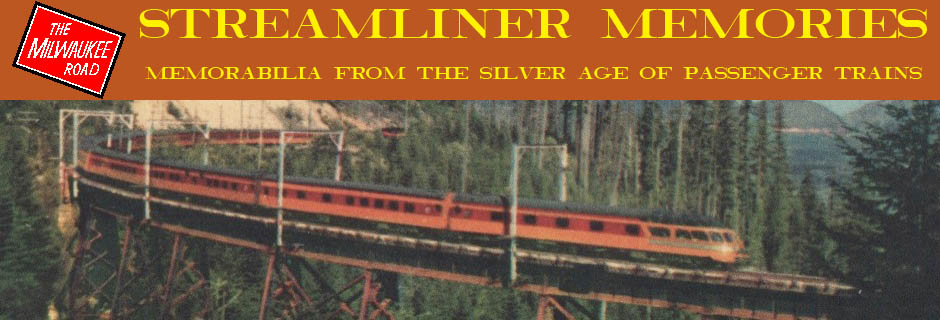On paper, the Burlington Zephyr was very similar to the Union Pacific M-10000. Both were lightweight, three-car trains powered by 600-horsepower internal combustion motors; both rode on articulated trucks (meaning adjacent cars shared wheel sets); both were smaller in profile than regular passenger cars.
Click on most images for a larger version.
Yet the differences between the two trains were almost as substantial as the similarities. With its resemblance to the 1934 Chrysler Airflow, the M-10000 certainly had “modern” styling, yet it looks dated today. The Zephyr, however, looks as fresh and modern today as it did in 1934. Indeed, some recent passenger locomotives have similar, if less elegant, shovel noses. The gleaming stainless steel left the brown-nosed M-10000 in the shadows. Technically, the Zephyr’s use of stainless steel and Diesel power put it a generation ahead of the M-10000.
The Zephyr was the joint brainchild of two Budds: Ralph Budd, the president of the Chicago, Burlington & Quincy; and Edward Budd, the founder of the Budd Company, which specialized in metalwork for the auto and rail industries. Stainless steel weakens when it is heated, so it can’t be welded using ordinary methods, but the Budd Company developed a technique it called “shot welding” that allowed it to join stainless steel panels together. The resulting body was so strong that it eliminated the need for a sill that had been used in all previous rail passenger cars.
Ralph Budd, meanwhile, had seen a working model of a General Motors Diesel at the 1933 Chicago Century of Progress fair (which lasted two summers), and ordered one to go into the railroad’s first streamlined train. He was also the person who came up with the name Zephyr, a name inspired by reading Chaucer’s Canterbury Tales, where he learned that Zephyrus was the god of the west wind. Budd, no relation to Edward, had been the youngest railroad president in the country when he was made president of the Great Northern Railway at age 40, and despite a busy career was erudite enough to read Middle English books in his spare time.

Unlike the M-10000, which had a kitchen in the tail of the train, the Zephyr had a small kitchen in the front of the train. At the rear, the Zephyr offered passengers a round-tailed observation car with a twelve-seat lounge where sightseers could watch the scenery go by. This became the pattern for almost all future streamlined trains.
To add insult to the Union Pacific’s self-inflicted injury, the Zephyr grabbed the headlines when it made a record-breaking, non-stop run from Denver to Chicago at an average speed of 77 mph and top speeds above 112 mph. It arrived in Chicago in time to be displayed at the same “Century of Progress” fair where Union Pacific distributed its M-10000 brochures. (The Union Pacific later countered by sending its second streamliner, the M-10001, on a record-breaking coast-to-coast run in less than 58 hours.)

To publicize its train, the Burlington handed out the brochure shown below, which unsuccessfully attempts to replicate the mirror-like qualities of stainless steel with a gunmetal-grey ink. Click on the image below to download the entire 3.1-MB brochure. Parts of the brochure will appear upside down because it was printed to be folded.

Curiously, the image of the train on the cover of this brochure is cut away, allowing readers to fold it and see three different scenes: a steam locomotive in a rural setting; the Zephyr in the same setting; and the Zephyr at the Chicago fair. Click on the image below to get a 1-MB PDF that shows all three options.



